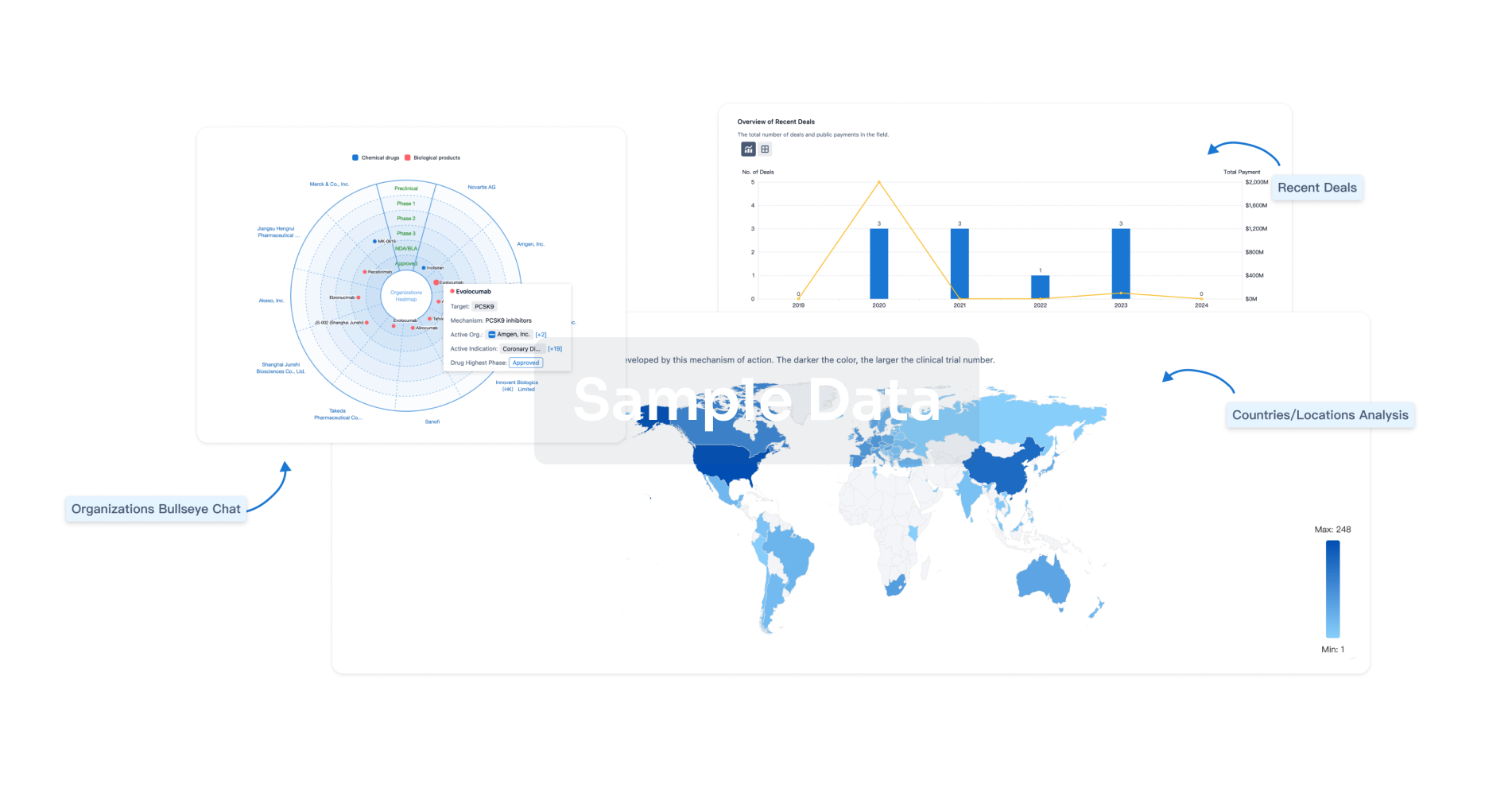Request Demo
Last update 08 May 2025
Opioid receptors x SCNA x μ opioid receptor
Last update 08 May 2025
Basic Info
Related Targets |
Related
2
Drugs associated with Opioid receptors x SCNA x μ opioid receptorTarget |
Mechanism SCNA blockers [+1] |
Active Org. |
Originator Org. |
Active Indication |
Inactive Indication- |
Drug Highest PhaseApproved |
First Approval Ctry. / Loc. United Kingdom |
First Approval Date01 Jan 2012 |
Mechanism Opioid receptors agonists [+2] |
Active Org.- |
Originator Org. |
Active Indication- |
Inactive Indication |
Drug Highest PhaseDiscontinued |
First Approval Ctry. / Loc.- |
First Approval Date20 Jan 1800 |
15
Clinical Trials associated with Opioid receptors x SCNA x μ opioid receptorCTRI/2023/08/056421
Efficacy of intrathecal 0.5% Bupivacaine with fentanyl & 0.5% Bupivacaine with Butorphanol in lower limb surgeries - Nil
Start Date26 Aug 2023 |
Sponsor / Collaborator- |
CTRI/2023/07/055401
Comparison of effects of epidural infusion with 0.125% Ropivacaine and Bupivacaine with Fentanyl for post operative analgesia in abdominal surgeries .A prospective randomised double blind study.
Start Date27 Jul 2023 |
Sponsor / Collaborator- |
100 Clinical Results associated with Opioid receptors x SCNA x μ opioid receptor
Login to view more data
100 Translational Medicine associated with Opioid receptors x SCNA x μ opioid receptor
Login to view more data
0 Patents (Medical) associated with Opioid receptors x SCNA x μ opioid receptor
Login to view more data
25
Literatures (Medical) associated with Opioid receptors x SCNA x μ opioid receptor03 Dec 2024·Clinical Practice & Epidemiology in Mental Health
Pharmacogenetic Testing in Treatment-resistant Panic Disorder: a Preliminary Analysis
Article
Author: Nardi, Antonio Egidio ; Zugliani, Morena Mourao ; Gomez, Manuella Assad ; do Cabo, Mariana Costa ; Martins, Renan Machado ; Fidry, Marcos ; Freire, Rafael C ; Faria, Clara Gitahy Falcão
01 Jan 2023·Journal of Endodontics
Association Between Single-nucleotide Polymorphisms in Candidate Genes and Success of Pulpal Anesthesia after Inferior Alveolar Nerve Block
Article
Author: Kahraman, Çiğdem Y ; Karataş, Ertuğrul ; Çakmak, Fatma A ; Sümbüllü, Meltem
03 Aug 2022·RheumatologyQ2 · MEDICINE
Interplay between genetics and lifestyle on pain susceptibility in women with fibromyalgia: the al-Ándalus project
Q2 · MEDICINE
Article
Author: Martínez-González, Luis J ; Geenen, Rinie ; Álvarez-Gallardo, Inmaculada C ; Aparicio, Virginia A ; Álvarez-Cubero, María J ; Gavilán-Carrera, Blanca ; Guerrero-González, Juan M ; Ruiz, Jonatan R ; Estévez-López, Fernando ; Camiletti-Moirón, Daniel ; Segura-Jiménez, Víctor ; Soriano-Maldonado, Alberto ; Acosta-Manzano, Pedro ; Delgado-Fernández, Manuel ; Salazar-Tortosa, Diego
1
News (Medical) associated with Opioid receptors x SCNA x μ opioid receptor06 Mar 2025
Tris Pharma said Thursday that its experimental pain drug delivered significant relief in another Phase III trial — this time in patients recovering from foot surgery. The results of ALLEVIATE-2 come weeks after a successful readout from ALLEVIATE-1, a late-stage study testing cebranopadol (TRN-228) in post-abdominoplasty surgery patients.Cebranopadol acts on both nociceptin/orphanin FQ peptide (NOP) and μ-opioid peptide (MOP) receptors, a mechanism Tris refers to as "dual-NMR agonism." By stimulating the NOP receptor, the company says its drug mitigates MOP-related side effects such as dependence, euphoria, respiratory depression and addiction, potentially reducing the risks associated with traditional opioid painkillers.Filing preparations"With our Phase III programme for cebranopadol… complete, we now have a comprehensive data package that will be submitted to the FDA as the basis for potential approval," said CEO Ketan Mehta. A US filing is planned for 2025.ALLEVIATE-2 tested cebranopadol against a placebo in about 240 patients with moderate-to-severe pain after bunionectomy, using an 11-point NRS pain scale.A daily 400 µg dose of oral cebranopadol reduced pain by 56.1 points compared to placebo. In a separate arm of the study, oxycodone IR 10 mg, given four times daily, provided more pain relief than placebo, but was less effective than cebranopadol based on NRS scores, according to a post-hoc analysis.Further, results over the course of the seven-day study period showed that 57.5% of cebranopadol patients did not require opioid rescue medication, compared to 28.4% in the placebo group. Tris said no serious adverse events were reported and nausea was the most common side effect.Filling a gapTodd Bertoch, lead investigator on ALLEVIATE-2, said "the biggest challenge in the search for new drugs for pain has been finding something safe that can treat more severe pain that today requires use of an opioid. The level of analgesia seen across both ALLEVIATE-1 and ALLEVIATE-2 as well as the safety data that has been generated suggest that cebranopadol could fulfill this urgent need."Full results from both studies will be presented at an upcoming medical congress. If approved, cebranopadol would provide another option in the quest for alternatives to traditional opioids. A few weeks ago, Vertex Pharmaceuticals won FDA approval for Journavx (suzetrigine), a non-opioid pain drug that blocks NaV1.8 sodium channels to reduce pain signaling (see – Spotlight on: The drugs that will shape 2025).Tris officials have said that while Journavx targets the gap between NSAIDs and opioids, cebranopadol is aimed at those "who can only be treated effectively with an opioid today."
Clinical ResultPhase 3Drug Approval
Analysis
Perform a panoramic analysis of this field.
login
or

AI Agents Built for Biopharma Breakthroughs
Accelerate discovery. Empower decisions. Transform outcomes.
Get started for free today!
Accelerate Strategic R&D decision making with Synapse, PatSnap’s AI-powered Connected Innovation Intelligence Platform Built for Life Sciences Professionals.
Start your data trial now!
Synapse data is also accessible to external entities via APIs or data packages. Empower better decisions with the latest in pharmaceutical intelligence.
Bio
Bio Sequences Search & Analysis
Sign up for free
Chemical
Chemical Structures Search & Analysis
Sign up for free
